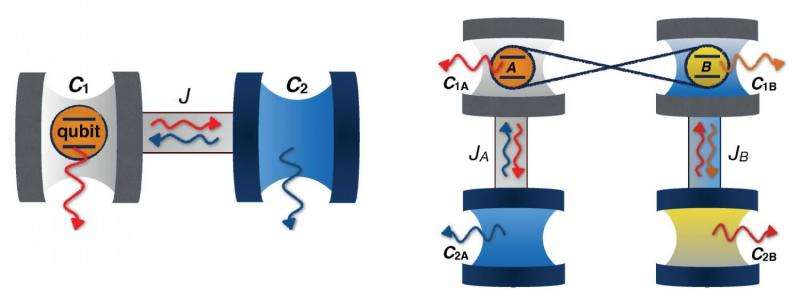September 14, 2015 report
Best of Last Week—Extending entanglement time, a Frankenvirus and slowing aging muscle degradation

(Phys.org)—It was another good week for physics as an international team of researchers found a way to extend the lifetime of entangled particles by orders of magnitude by using coupled cavities—they adjusted the coupling strength between the two cavities in which the qubits were embedded.
It was also an interesting week for computer technological development—a team of researchers at MIT unveiled a more efficient memory-management scheme that could help enable chips with thousands of cores—a new approach to cache management that would drastically reduce the amount of memory dedicated to maintain a shared cache. Also another trio of researchers with Princeton and Andrés Bello National University in Chile came up with a new limit to the Church-Turing thesis that accounts for noisy systems—preventing newer physical systems from violating the famous ideas that define what future computers should be capable of doing.
It was also a really big week for biological research news, first as a Frankenvirus emerged from Siberia's frozen wasteland—a giant-sized virus from 30,000 years ago was found by a team of French researchers; they plan to thaw it out to better study it. Also, an international effort led to the creation of the world's largest protein map—they expect it to reveal which proteins work together in a cell. Another study by a team of researchers from the U.S. and Australia wondered if it was grandmas that were responsible for early people pairing up—in their study, they found that human longevity from grandmothering was tied to human coupling—they believe it was grandmother's caring for offspring that led to pairing and a longer life. Another international team of researchers found that hummingbirds find protection building nests under hawks—the smaller birds, they found, were too small and fast to serve as prey, leaving the hawks to feast on other hummingbird predators. Also, a team of researchers in the U.S. announced that they had created an implant that captures cancer cells in mice. The hope is that it can interfere in metastasis. And another team at Stanford produced a cancer drug from a rare plant in their lab, which means that in the future, patients won't have to worry about a supply lapse.
And finally, if you have found that as you grow older, you seem to be getting weaker, there may be hope ahead, as a team of scientists has discovered the cause of and potential treatment for muscle weakness and loss due to aging—the team, with the University of Iowa, found that the protein ATF4 is a transcription factor that causes changes to gene expression. They also found two natural compounds that reduce ATF4 activity, which means there might soon be a way to stop it from happening.
Journal information: Scientific Reports
© 2015 Phys.org





















